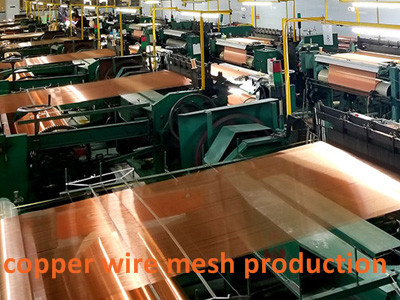Copper and brass wire mesh are widely used in various applications due to their electrical conductivity, corrosion resistance, and aesthetic appeal. The processing of copper/brass wire mesh involves several steps to transform raw materials into the final mesh product. Here is a description of the typical processing steps:
Wire Drawing: The first step in the processing of copper/brass wire mesh is wire drawing. Copper or brass wires in their raw form are drawn through a series of dies to reduce their diameter to the desired size. This process improves the wire’s tensile strength and surface finish.
Wire Annealing: After wire drawing, the copper or brass wire is often subjected to an annealing process. Annealing involves heating the wire to a specific temperature and then cooling it slowly. This process relieves internal stresses and improves the wire’s ductility and workability.
Weaving: The woven wire mesh is created by interlacing the copper or brass wires on specialized weaving machines. Different weaving patterns, such as plain weave, twill weave, or Dutch weave, can be used to achieve specific mesh structures and characteristics. The weaving process involves carefully aligning and interlocking the wires to create a uniform and stable mesh.
Mesh Inspection: Once the wire mesh is woven, it undergoes a thorough inspection to ensure its quality and compliance with specifications. The mesh is examined for any defects, such as broken wires, irregularities in the weave, or incorrect mesh count. This inspection helps maintain the integrity and performance of the wire mesh.
Cutting and Shaping: Copper/brass wire mesh is often produced in rolls or panels. Depending on the intended application, the mesh may need to be cut or shaped into specific dimensions. Specialized cutting tools, such as wire cutters or shears, are used to trim the mesh to the desired size or shape without causing damage to the wires.
Surface Treatment: Copper/brass wire mesh can undergo surface treatments to enhance its properties or appearance. Surface treatments can include processes like cleaning, polishing, or coating with protective materials to improve corrosion resistance, provide a specific aesthetic finish, or enhance conductivity for electrical applications.
Final Inspection and Packaging: Before packaging, the finished copper/brass wire mesh is subjected to a final inspection to ensure it meets the required quality standards. This inspection includes verifying dimensions, mesh count, wire diameter, and overall mesh integrity. Once approved, the wire mesh is carefully packaged to protect it during storage, transport, and handling.
